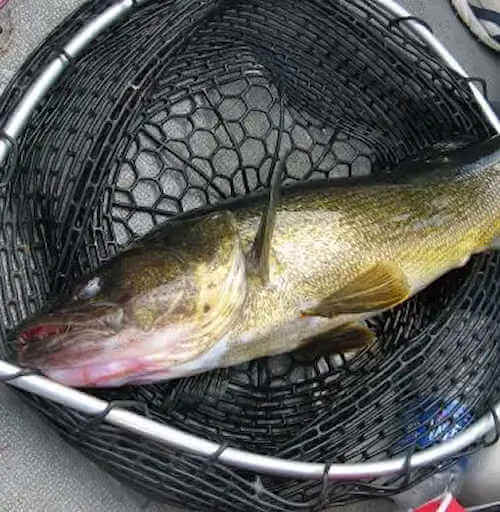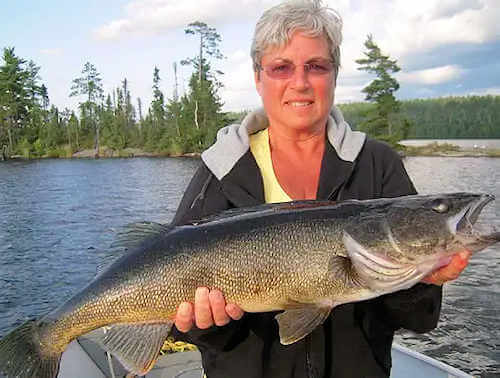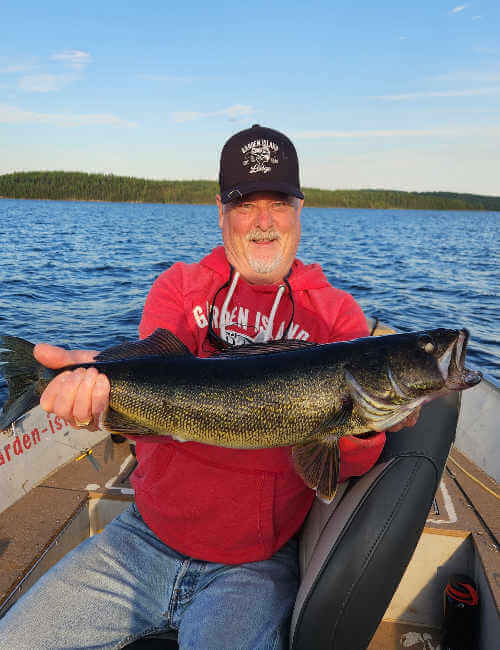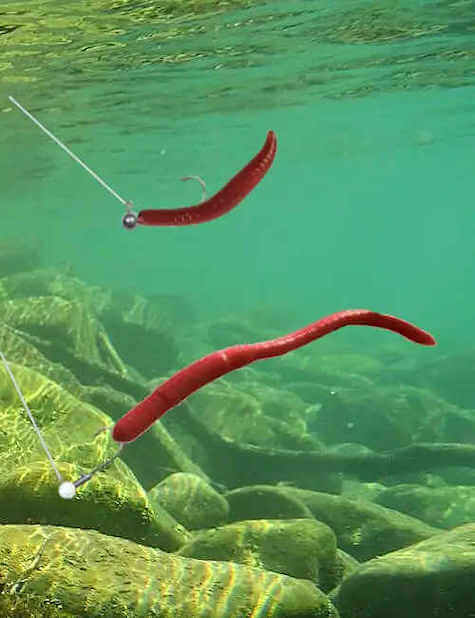Improve Your Walleye Catch Ratio on Lady Evelyn Lake
The reason so many people love walleye fishing is because walleye are a special breed of creature that can be a lot of fun to catch (especially on light tackle). For many, a large part of the fun is just figuring out the walleyes' seasonal patterns, pinpointing their locations, and discovering their feeding habits. I learned an incredible secret about walleye that has doubled, tripled and sometimes even quadrupled my walleye catch ratios.
Walleye are normally one of the top two dominant predators in any lake they reside. They have learned to hunt in groups and, as most anglers already know, they have developed eyes that give them a distinct advantage over their prey in low light conditions. Walleye are well known for being almost exclusively nighttime feeders in most lakes. (Just not on Lady Evelyn). Don’t think you have to miss sleep in order to catch plenty of walleye here on Lady Evelyn. Surprisingly walleye are readily available during daylight hours. I encourage walleye anglers to read carefully on how to adjust their own tactics to catch more of them in the daylight.
During daylight hours, especially morning and evening hours, walleye tend to remain close to those same areas where they were feeding during the night. Many of these night feeding walleye tend to hang around in the morning hours simply because they didn’t fill themselves adequately during their night feeding forays. Maybe it was too light or maybe the barometric pressure wasn’t right but the fact remains they still need to eat in order to survive.

So why do walleye seem so hard to locate and catch during the daylight hours? Walleye feed differently during daylight hours then they feed in the dark. At night their unique eyes give them a tremendous advantage over baitfish. They will strike and swallow their prey without mercy or the slightest hesitation. In the dark, a walleye has the upper hand and they know it. They'll use their advantage in every low light feeding opportunity.
However, daylight is an entirely different matter. Walleye will no longer have an advantage over perch and other baitfish. Walleye are not stealth feeders. They don't hide behind structure and dart out to devour a meal. On Lady Evelyn the walleyes' prey species are most active during the daylight hours. The prey has evolved to be faster and more wary during daylight hours. In response, the walleye have over time developed a unique way of feeding during daylight hours.
Give Yourself The Daytime Advantage

During the daylight hours the walleye are slightly less sure of their ability to catch a baitfish. So to compensate a walleye will "strike" at the prey with no intention of eating it. The walleye have learned that it has to conserve the energy it expends during the day. So instead it will stun the prey by snapping at it with those two sharp canine type razor sharp teeth only intending to stun it. Next instead of chasing the walleye will just watch to see what happens to the baitfish it just stunned. If the baitfish begins to fall and flutter to the bottom, the walleye will follow as it drops similar to a cat playing with a mouse. If after the bait settles to the bottom it begins to move again, the walleye will again just snap at it to stun it.
However, it’s important to note, if a walleye snaps at your bait and you briskly yank the bait away, there is little chance that the walleye will want to waste the energy necessary to chase it down again. That’s because the first rule of nature says that no creature should expend more energy chasing its prey than it will receive in calories from that prey when it catches and eats it.
So let’s put this information into a strategy to catch more fish. Let’s say that you are drifting along with a jig and worm through a productive area on a moderately windy day. You are using a jig that is just heavy enough to get to the bottom in the heavy wind. On light 6# test line an 1/8 oz. jig will stay near the bottom while the boat is drifting at 4 to 5 mph. Occasionally you might feel a tap-tap-tap of a perch or a bluegill. That’s because the small bait stealers like to grab a worm and just hang on for the ride. Those tap-tap-taps are likely NOT walleye! Walleye will snap hard and quickly release. Train yourself not to set the hook on the tap-tap-tap bait stealers!
Special Note: With this tactic, the first basic rule is NEVER "set the hook" on a tap. Heed this warning, until you can train your mind to stop "setting the hook" it will always be your natural instinct. You will set the hook and you are also going to lose your bait often times when you do. If you are using your lightest tackle with the sharpest hooks, it is never going to be necessary to set the hook when walleye fishing! I'll explain why this is true.
If the bite is a perch or bluegill and you do set the hook, you probably just wasted a good worm. If it was a walleye, it will not go tap-tap-tap. During the daylight hours, when it is a walleye, all you will feel is a quick and more solid single strike and then nothing. That single tap was the walleye “stunning” his intended meal. Just after this tap, the walleye wants and expects to see the injured bait flutter towards the bottom. The walleye follows it and watches it as it falls to the bottom. The split second you move it again he will snap at it trying again to stun it.
About this time you’re probably thinking that would now be the time to set the hook. If you want to increase your catch ratio, don’t set the hook! I hope that you are starting to get a theme here. Especially if you are jig and worm fishing, you will never need to "set the hook" to catch a walleye. Your jig should always be small enough and sharp enough that it will catch itself in the walleye’s mouth without any need to jerk at it. Only when the walleye has finally hooked itself and you feel the additional weight slowly pulling steadily on your line is it time to start reeling. Now instead of dropping the bait to the bottom again you will be able to sweep your rod with a steady motion and begin to head the walleye your way.
Your next question might be why am I NOT setting the hook? The key reason is because if you set the hook you will be pulling the bait out of the small range that a walleye is willing to expend enough energy chase it down. I call this method "dropping back to walleye" and I have proven it works to everyone that I have fished with. By learning to drop back every time a walleye "stuns" your bait I guarantee that your catch ratio will increase substantially beyond your expectations.

The Most Effective Way to Catch Walleye on Lady Evelyn!

One of the most effective ways to catch walleye on Lady Evelyn Lake is also the simplest and least expensive way to catch fish anywhere. Use a super sharp small 1/8 oz. jig and half a nightcrawler with the jig tied straight to 6# test monofilament and drag it near the bottom! Sounds to good to be true doesn't it? I have used this same method to catch 20 pound hybrid stripers and 30 pound blue catfish with my same walleye gear and 6# mono line. It just works!
There are a few refinements that I have learned over the years that I'd like to pass along. If the weather is calm enough, and you are using 6# monofilament, go ahead and scale down to a 1/16 oz. jig with a sharp gold aberdeene hook. Walleye actually hook themselves with these tiny jigs and because these jigs are lighter than the 1/8 oz. jig, they seem to ride just slightly off the bottom and rarely get snagged. If your tiny jig does get snagged, don't pull hard on it because the snag is almost always one of the many rocks in this lake. Turn around and go back beyond where the jig is snagged, shake it a couple times, and it will fall free. If it doesn't fall free, pull with a steady pressure until the hook straightens enough to pull free.
Jig color is not very important on most days but I have seen days when white or even pink jigs seem to catch more walleye. One of the times when jig color does make a difference is under low light conditions like early morning, dusk after the sun hits the treetops and cloudy rainy days. For some reason walleye seem to be attracted to those tiny bright white or pink heads better.
Most of the time you will get more walleye strikes when you are using just half a nightcrawler. When using a half crawler you'll probably also hook more fish. However there is one exception. If you are fishing for a trophy walleye 26" plus in those prime low light hours mentioned above use the largest and liveliest whole nightcrawler in the box hooked lightly through the tip of the snout. The small walleye tend to hit a large nightcrawler in the center of its body or the tail just to try and stun it. Big walleye don't hesitate to grab the entire large nightcrawler and a bonus is the walleye's natural instinct is to attack it head first right where your jig and hook are. By hooking the crawler in the tip of nose there is more chance of catching the walleye and not just hooking through multiple layers of the crawler.
Practically all methods that work for walleye everywhere else will work for catching walleye here. However, there is no need to use expenive fancy methods when the old basics are already so effective.